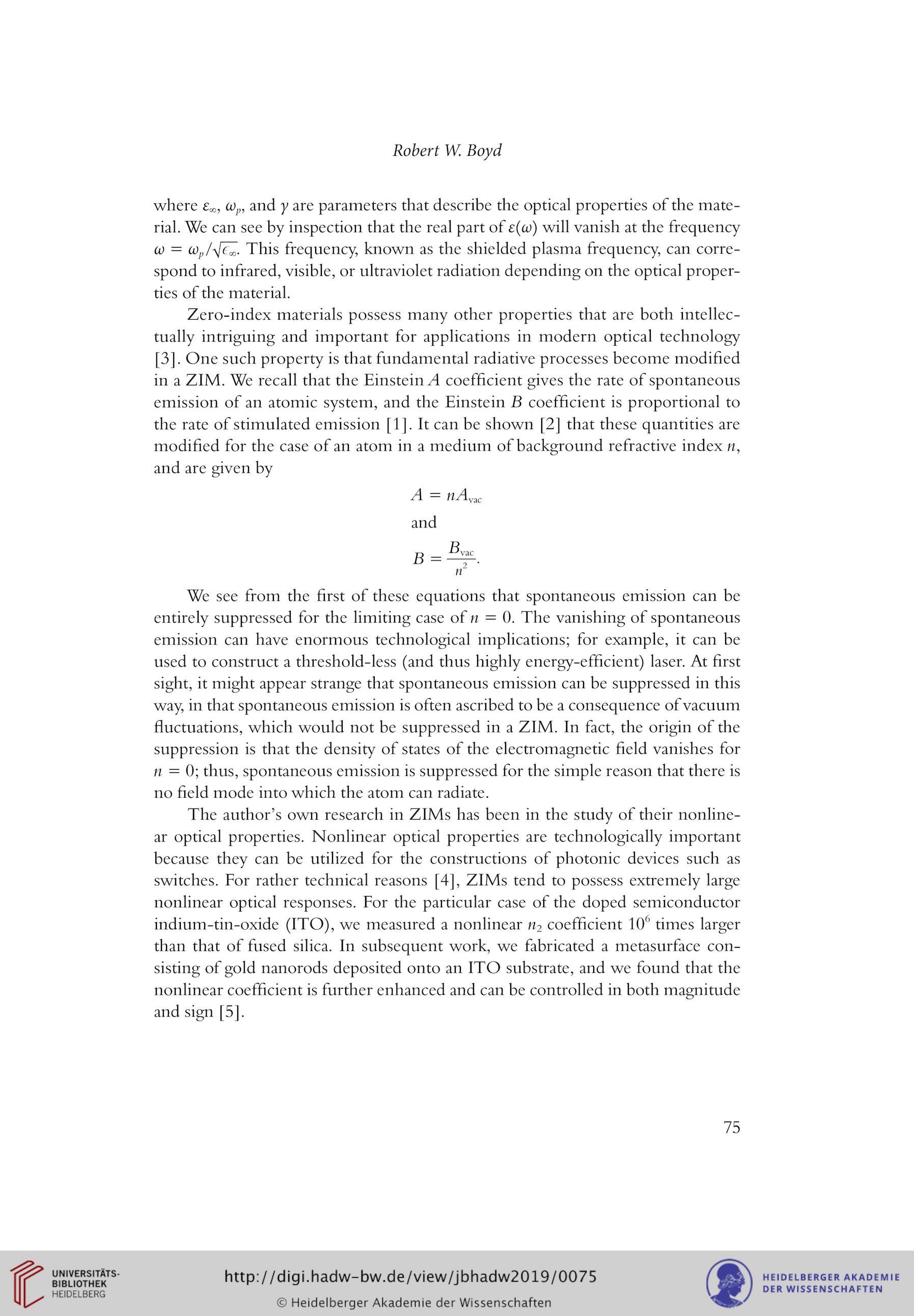Heidelberger Akademie der Wissenschaften [Hrsg.]
Jahrbuch ... / Heidelberger Akademie der Wissenschaften: Jahrbuch 2019
— 2020
Zitieren dieser Seite
Bitte zitieren Sie diese Seite, indem Sie folgende Adresse (URL)/folgende DOI benutzen:
https://doi.org/10.11588/diglit.55176#0075
DOI Kapitel:
A. Das akademische Jahr 2019
DOI Kapitel:II. Wissenschaftliche Vorträge
DOI Artikel:Boyd, Robert W.: How light behaves when the refractive index vanishes
DOI Seite / Zitierlink:https://doi.org/10.11588/diglit.55176#0075
- Schmutztitel
- Titelblatt
- Inhaltsverzeichnis
-
A. Das akademische Jahr 2019
-
11-48
I. Jahresfeier am 18. Mai 2019
- 11-12 Begrüßung durch den Präsidenten Thomas Holstein
- 13-15 Grußwort des Präsidenten der Deutschen Akademie der Naturforscher Leopoldina Jörg Hacker
- 16-21 Rechenschaftsbericht des Präsidenten
- 22-23 Kurzbericht der Sprecherin des WIN-Kollegs Daniela Mier: „JungeWissenschaft in der Akademie: das WIN-Kolleg“
- 24 Verleihung der Preise
-
49-80
II. Wissenschaftliche Vorträge
- III. Veranstaltungen
-
11-48
I. Jahresfeier am 18. Mai 2019
- B. Die Mitglieder
-
C. Die Forschungsvorhaben
- 223-224 I. Forschungsvorhaben und Arbeitsstellenleiter
-
225-331
II. Tätigkeitsberichte
- 225-228 1. Deutsche Inschriften des Mittelalters
- 229-234 2. Wörterbuch der altgaskognischen Urkundensprache (DAG)
- 234-240 3. Deutsches Rechtswörterbuch
- 240-242 4. Goethe-Wörterbuch (Tübingen)
- 242-246 5. Melanchthon-Briefwechsel
- 246-249 6. Altfranzösisches etymologisches Wörterbuch (DEAF)
- 250-255 7. Epigraphische Datenbank römischer Inschriften
- 255-260 8. Edition literarischer Keilschrifttexte aus Assur
- 261-267 9. Buddhistische Steininschriften in Nordchina
- 267-274 10. Geschichte der südwestdeutschen Hofmusik im 18.Jahrhundert (Schwetzingen)
- 275-287 11. The Role of Culture in Early Expansions of Humans (Frankfurt/Tübingen)
- 287-293 12. Nietzsche-Kommentar (Freiburg)
- 293-298 13. Klöster im Hochmittelalter: Innovationslabore europäischer Lebensentwürfe und Ordnungsmodelle (Heidelberg/Dresden)
- 299-305 14. Der Tempel als Kanon der religiösen Literatur Ägyptens (Tübingen)
- 306-310 15. Kommentierung der Fragmente der griechischen Komödie (Freiburg)
- 310-314 16. Kommentierung und Gesamtedition der Werke von Karl Jaspers sowie Edition der Briefe und des Nachlasses in Auswahl
- 314-318 17. Historisch-philologischer Kommentar zur Chronik des Johannes Malalas
- 319-325 18. Religions- und rechtsgeschichtliche Quellen des vormodernen Nepal
- 325-331 19. Theologenbriefwechsel im Südwesten des Reichs in der Frühen Neuzeit (1550–1620)
-
332-341
III. Drittmittel-geförderte Projekte
- 332-335 20. Nepal Heritage Documentation Project
- 335-338 21. Ludwik Fleck und seine ‚Denkkollektive‘: Der (Lemberger) Entstehungskontext seiner Ideen vom Denkstil und Denkkollektiv und ihre interdisziplinäre Rezeption
- 338-340 22. Individualisierung und Demokratisierung der Versorgung von Krebspatienten mittels künstlicher Intelligenz: transdisziplinäre Lösungen und normative Überlegungen
- 340-341 23. EUCANCan: a federated network of aligned and interoperable infrastructures for the homogeneous analysis, management and sharing of genomic oncology data for Personalized Medicine
-
D. Förderung des wissenschaftlichen Nachwuchses
-
I. Die Preisträger
- 343-344 Akademiepreis
- 345 Karl-Freudenberg-Preis
- 346 Walter-Witzenmann-Preis
- 347-348 Ökologiepreis der Viktor-und-Sigrid-Dulger-Stiftung
-
349-351
Manfred-Fuchs-Preis
- 349-350 Julia Burkhardt: „Von Bienen lernen. Das Bonum universale de apibus des Thomas von Cantimpré als Gemeinschaftsentwurf (Analyse, Edition, Übersetzung, Kommentar)“
- 350-351 Thomas Böttcher: „Virulenz krankheitserregender Bakterien, die Entwicklung neuer Antibiotika sowie die Untersuchung der chemischen Interaktionen zwischen Mikroorganismen“
-
II. Das WIN-Kolleg
- 352 Aufgaben und Ziele
- 353-354 Verzeichnis der WIN-Kollegiaten
-
355-385
Sechster Forschungsschwerpunkt „Messen und Verstehen der Welt durch die Wissenschaft“
- 355-357 1. Analyzing, Measuring and Forecasting Financial Risks by means of High-Frequency Data
- 358-363 2. Das menschliche Spiegelneuronensystem: Wie erfassen wir, was wir nicht messen können?
- 363-364 3. Quantifizierung in Politik und Recht am Beispiel von Wirtschaftssanktionen
- 365-368 4. Europäischer Datenschutz und Datenaustausch: interdisziplinäre Bedingungen und internationale Implikationen
- 369-372 5. CAL²Lab – Eine rechtslinguistische Experimentierplattform
- 373-375 6. „Working Numbers“: Science and Contemporary Politics
- 376-379 7. Thermischer Komfort und Schmerz – Untersuchungen zur Dynamik der Schmerz- und Komfortwahrnehmung
- 380-382 8. Charakterisierung von durchströmten Gefäßen und der Hämodynamik mittels modell- und simulationsbasierter Fluss-MRI (CFD-MRI)
- 383-384 9. Zählen und Erzählen. Spielräume und Korrelationen quantitativer und qualitativer Welterschließung
- 385 10. Metaphern und Modelle – Zur Übersetzung von Wissen in Verstehen
-
386-402
Siebter Forschungsschwerpunkt „Wie entscheiden Kollektive?“
- 386-388 11. Heiligenleben: Erzählte Heiligkeit zwischen Individualentscheidung und kollektiver Anerkennung
- 389-392 12. How does group composition influence collective sensing and decision making?
- 393-396 13. Fake News and Collective Decision Making. Rapid Automated Assessment of Media Bias
- 397-399 14. Heterogeneity and Convergence in Shared Data Sources – The Importance of Cognitive Coherence in Collective Decision Making
- 400-402 15. Ein transdisziplinäres Modell zur Struktur- und Musterbildung kollektiven Entscheidens: Synergieeffekte zwischen linguistischen, biologischen und physikalischen Ansätzen
- 403-406 III. Das Akademie-Kolleg
-
IV. Akademiekonferenzen
-
I. Die Preisträger
- 415-440 E. Anhang
- 447-455 Personenregister
Robert W. Boyd
where £«,, cop, and y are parameters that describe the optical properties of the mate-
rial. We can see by inspection that the real part of c(ci?) will vanish at the frequency
0) = ü)p/y[€^. This frequency, known as the shielded plasma frequency, can corre-
spond to infrared, visible, or ultraviolet radiation depending on the optical proper-
ties of the material.
Zero-index materials possess many other properties that are both intellec-
tually intriguing and important for applications in modern optical technology
[3]. One such property is that fundamental radiative processes become modified
in a ZIM. We recall that the Einstein A coefficient gives the rate of spontaneous
emission of an atomic System, and the Einstein B coefficient is proportional to
the rate of stimulated emission [1], It can be shown [2] that these quantities are
modified for the case of an atom in a medium of background refractive index n,
and are given by
A = nAV3C
and
B-*-*vac
“ 2~ *
n
We see from the first of these equations that spontaneous emission can be
entirely suppressed for the limiting case of n = 0. The vanishing of spontaneous
emission can have enormous technological implications; for example, it can be
used to construct a threshold-less (and thus highly energy-efficient) laser. At first
sight, it might appear stränge that spontaneous emission can be suppressed in this
way, in that spontaneous emission is often ascribed to bc a consequence of vacuum
fluctuations, which would not be suppressed in a ZIM. In fact, the origin of the
suppression is that the density of States of the electromagnetic field vanishes for
n = 0; thus, spontaneous emission is suppressed for the simple reason that there is
no field mode into which the atom can radiate.
The author’s own research in ZIMs has been in the study of their nonline-
ar optical properties. Nonlinear optical properties are technologically important
because they can be utilized for the constructions of photonic devices such as
switches. For rather technical reasons [4], ZIMs tend to possess extremely large
nonlinear optical responses. For the particular case of the doped semiconductor
indium-tin-oxide (ITO), we measured a nonlinear n2 coefficient 106 times larger
than that of fused silica. In subsequent work, we fabricated a metasurface con-
sisting of gold nanorods deposited onto an ITO Substrate, and we found that the
nonlinear coefficient is further enhanced and can be controlled in both magnitude
and sign [5],
75
where £«,, cop, and y are parameters that describe the optical properties of the mate-
rial. We can see by inspection that the real part of c(ci?) will vanish at the frequency
0) = ü)p/y[€^. This frequency, known as the shielded plasma frequency, can corre-
spond to infrared, visible, or ultraviolet radiation depending on the optical proper-
ties of the material.
Zero-index materials possess many other properties that are both intellec-
tually intriguing and important for applications in modern optical technology
[3]. One such property is that fundamental radiative processes become modified
in a ZIM. We recall that the Einstein A coefficient gives the rate of spontaneous
emission of an atomic System, and the Einstein B coefficient is proportional to
the rate of stimulated emission [1], It can be shown [2] that these quantities are
modified for the case of an atom in a medium of background refractive index n,
and are given by
A = nAV3C
and
B-*-*vac
“ 2~ *
n
We see from the first of these equations that spontaneous emission can be
entirely suppressed for the limiting case of n = 0. The vanishing of spontaneous
emission can have enormous technological implications; for example, it can be
used to construct a threshold-less (and thus highly energy-efficient) laser. At first
sight, it might appear stränge that spontaneous emission can be suppressed in this
way, in that spontaneous emission is often ascribed to bc a consequence of vacuum
fluctuations, which would not be suppressed in a ZIM. In fact, the origin of the
suppression is that the density of States of the electromagnetic field vanishes for
n = 0; thus, spontaneous emission is suppressed for the simple reason that there is
no field mode into which the atom can radiate.
The author’s own research in ZIMs has been in the study of their nonline-
ar optical properties. Nonlinear optical properties are technologically important
because they can be utilized for the constructions of photonic devices such as
switches. For rather technical reasons [4], ZIMs tend to possess extremely large
nonlinear optical responses. For the particular case of the doped semiconductor
indium-tin-oxide (ITO), we measured a nonlinear n2 coefficient 106 times larger
than that of fused silica. In subsequent work, we fabricated a metasurface con-
sisting of gold nanorods deposited onto an ITO Substrate, and we found that the
nonlinear coefficient is further enhanced and can be controlled in both magnitude
and sign [5],
75




